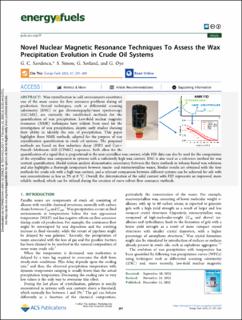| dc.contributor.author | Savulescu, George Claudiu | |
| dc.contributor.author | Simon, Sebastien Charles | |
| dc.contributor.author | Sørland, Geir Humborstad | |
| dc.contributor.author | Øye, Gisle | |
| dc.date.accessioned | 2023-02-14T08:48:36Z | |
| dc.date.available | 2023-02-14T08:48:36Z | |
| dc.date.created | 2022-12-14T09:57:29Z | |
| dc.date.issued | 2022 | |
| dc.identifier.citation | Energy & Fuels. 2022, 37 (1), 291-300. | en_US |
| dc.identifier.issn | 0887-0624 | |
| dc.identifier.uri | https://hdl.handle.net/11250/3050584 | |
| dc.description.abstract | Wax crystallization in cold environments constitutes one of the main causes for flow assurance problems during oil production. Several techniques, such as differential scanning calorimetry (DSC) or gas chromatography/mass spectroscopy (GC/MS), are currently the established methods for the quantification of wax precipitation. Low-field nuclear magnetic resonance (NMR) techniques have seldom been used for the investigation of wax precipitation, despite early studies showing their ability to identify the rate of precipitation. This paper highlights three NMR methods, adapted for the purpose of wax crystallization quantification in crude oil systems. The proposed methods are based on free induction decay (FID) and Carr–Purcell–Meiboom–Gill (CPMG) sequences. Both allow for the quantification of a signal that is proportional to the non-crystalline wax content, while FID data can also be used for the computation of the crystalline wax component in systems with a sufficiently high wax content. DSC is also used as a reference method for wax content quantification. Model system analysis demonstrates consistency between the three methods in toluene-based wax solutions and also highlights a thorough comparison between macro- and microcrystalline waxes. Similar results are obtained with the four methods for crude oils with a high wax content, and a relevant comparison between different systems can be achieved for oils with wax concentrations as low as 2% at 0 °C. Overall, the determination of the solid content with FID represents an improved, more reliable method, which can be utilized during the creation of more robust flow assurance methods. | en_US |
| dc.language.iso | eng | en_US |
| dc.publisher | American Chemical Society | en_US |
| dc.rights | Navngivelse 4.0 Internasjonal | * |
| dc.rights.uri | http://creativecommons.org/licenses/by/4.0/deed.no | * |
| dc.title | Novel Nuclear Magnetic Resonance Techniques To Assess the Wax Precipitation Evolution in Crude Oil Systems | en_US |
| dc.title.alternative | Novel Nuclear Magnetic Resonance Techniques To Assess the Wax Precipitation Evolution in Crude Oil Systems | en_US |
| dc.type | Peer reviewed | en_US |
| dc.type | Journal article | en_US |
| dc.description.version | publishedVersion | en_US |
| dc.source.pagenumber | 291-300 | en_US |
| dc.source.volume | 37 | en_US |
| dc.source.journal | Energy & Fuels | en_US |
| dc.source.issue | 1 | en_US |
| dc.identifier.doi | 10.1021/acs.energyfuels.2c03309 | |
| dc.identifier.cristin | 2092886 | |
| cristin.ispublished | true | |
| cristin.fulltext | original | |
| cristin.qualitycode | 2 | |

